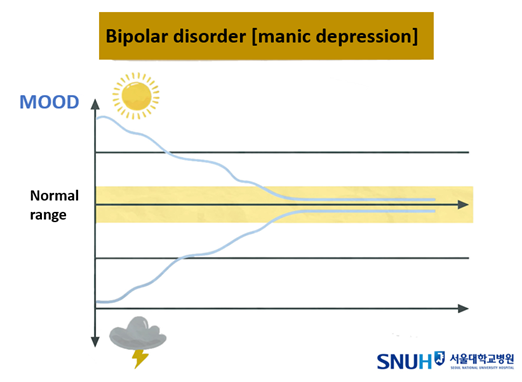[SNUH Health Information] ‘Bipolar disorder’ has two faces
[SNUH Health Information] ‘Bipolar disorder’ has two faces
- Professor Ahn Yong-Min, Department of Psychiatry, Seoul National University Hospital, introduces bipolar disorder symptoms and treatment

[Photo] Professor Ahn Yong-Min, Department of Psychiatry

Ordinary people show various emotional changes in each situation, such as laughing when they are happy and crying when they are sad. However, if these emotional changes occur abnormally and extremely, it is necessary to suspect whether it is a mood disorder.
We looked into the definition, symptoms and treatment of bipolar disorder, also known as manic depression, with Professor Ahn Yong-Min of the Department of Psychiatry at Seoul National University Hospital.
1. Definition of bipolar disorder
‘Bipolar disorder’, also known as manic depression, is a disease in which manic episodes, a state of abnormal excitement, and depressive episodes, a depressive state, alternate. Bipolar disorder is one of the representative mood disorders. It is medically called bipolar disorder because the person's mood swings between the extremes of mania and depression.
Bipolar disorder is characterized by manic or hypomanic episodes. During a manic or hypomanic episode, patients appear to be abnormally excited or have increased energy, do not feel tired even if they do not sleep, and speak and think faster.
Manic episodes of bipolar disorder are clinically distinct from depressive disorders. However, depressive episodes of bipolar disorder show similar patterns to depressive disorders, and because patients usually visit hospitals while depressed, patients with bipolar disorder are likely to be diagnosed with depressive disorder at first.
Even if they have the same depressive condition, the treatment direction for bipolar disorder and depression may be different, so it is important to distinguish them well through consultation with a psychiatrist, history taking, and evaluation.
2. Cause
The cause of bipolar disorder is not yet clearly known. To date, it is assumed that bipolar disorder occurs due to a combination of biological and environmental factors.
Although not all patients with bipolar disorder have a family history, the tendency for it to be inherited is quite high. Previous studies have shown that biological factors account for about 70 to 80% and environmental factors such as stress account for the remaining 20 to 30%.
3. Symptoms by type
Bipolar disorder is divided into 'bipolar disorder type 1', which is characterized by manic episodes with abnormally elevated mood, and 'bipolar disorder type Ⅱ', which is characterized by hypomanic episodes with milder symptoms and relatively shorter duration than manic episodes.
Bipolar disorder type I involves both manic episodes and depressive episodes. Manic episodes are characterized by heightened mood, exaggerated self-confidence, and inflated self-esteem. Additionally, the desire for sleep decreases, making it difficult to sleep. Goal-oriented activities increase, and people may become preoccupied with hedonic activities or reckless gambling, which can lead to painful results.
In a manic episode, there is usually no illness, so patients are often brought to the hospital by their guardians rather than by themselves. When manic symptoms are severe, prompt hospitalization is required.
In bipolar disorder type II, hypomanic episodes and depressive episodes occur together. During a hypomanic episode, the mood is high, but not as severe as a manic episode. Rather, many creative thoughts arise, and artistic or productive activities are displayed.
In bipolar disorder type II, hypomania is rarely a problem, but symptoms of depression that appear after hypomania are problematic. Depression after hypomania is known to last longer and be more difficult to treat than general depression and has a high risk of suicide. Therefore, in order to prevent the recurrence of depressive episodes in bipolar II disorder, treatment is needed starting with hypomania.
4. Treatment
The most basic and important treatment for bipolar disorder patients is drug treatment. It is important to develop a comprehensive treatment plan that integrates psychotherapeutic approaches with a focus on drug treatment. Various drugs, including lithium, are used in clinical settings.
Most patients with bipolar disorder visit the hospital depressed, and when antidepressants are given during bipolar disorder depressive episodes, depression symptoms sometimes do not improve or even worsen. Because impulsivity and mood swings can aggravate and, in some cases, raise the risk of suicide, antidepressants should be used with caution, and treatment should focus on mood regulators or antipsychotics for bipolar disorder patients.
Maintaining regular daily routines is extremely important for bipolar disorder patients. Because changes in sleep time have a significant impact on their mood, patients with bipolar disorder should maintain a good daily rhythm through regular sleep and sufficient exercise. Because alcohol might make your mood more unstable, you should avoid it if you want to avoid mood symptoms.
Furthermore, it is quite difficult for patients to take medication every day. Therefore, roommates, family members, and guardians living with the patient must monitor the patient's medication compliance and provide encouragement.
5. A word to patients
“In the case of bipolar disorder patients, if they receive consistent treatment, there are many who have no symptoms at all or who do relatively well even if they do have symptoms.
“"I hope that through their own proactive treatment motivation and the warm care of their families, patients can lead healthy and happy lives."